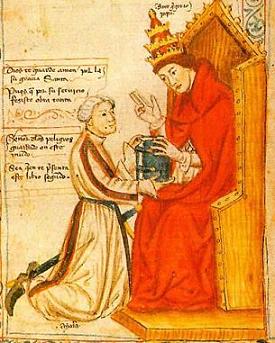Pero López de Ayala facts for kids
Pero López de Ayala (born 1332, died 1407) was an important person in the Kingdom of Castile. He was a politician, historian, poet, and a chronicler (someone who writes down history). He also held important jobs like chancellor (a high-ranking official) and courtier (someone who works for the king).
Contents
Life of Pero López de Ayala
Pero López de Ayala was born in 1332 in Vitoria, a city in the Kingdom of Castile. His parents were Fernán Pérez de Ayala and Elvira Álvarez de Cevallos. He was taught by his great-uncle, Cardinal Pedro Gómez Barroso.
The Ayala family was one of the most important noble families in Castile. Pero's father wrote that their family came from Christian royalty in the Pyrenees mountains.
Pero López de Ayala first supported Pedro of Castile, who was the king. But later, he changed his mind and supported Henry of Trastamara, who wanted to be king instead.
As a military leader, he fought with Henry at the Battle of Nájera in 1367. He was captured by the Black Prince, a famous English commander. But he was later set free. In 1378, he traveled to France to arrange an alliance against England and Portugal.
He then served John I of Castile, who became king. In 1385, he was captured by the Portuguese at the Battle of Aljubarrota. He was put in a prison made of iron. While he was in prison, he wrote two books: his Libro de la caza de las aves (which means "Book on hunting with birds") and parts of his Rimado de Palacio.
Many people helped to get him released from prison. These included his wife, Doña Leonor de Guzmán, and the kings of Castile and France. He was finally set free after a large payment of 30,000 doubloons (a type of old coin).
After his release in 1388 or 1389, he continued his work as a diplomat in France. He later returned to Castile. There, King Henry III named him Canciller mayor, which means "grand chancellor of the realm." This was a very high position. Pero López de Ayala died in Calahorra when he was 75 years old.
Literary Works
Pero López de Ayala is best known for his book of poems called Libro Rimado de Palacio. This title means "Palace Verse" or "Rhymes of the Court." In this book, he used satire (a way of making fun of things to show their flaws) to describe the people of his time. He wrote about their social, religious, and political ideas.
His poems are like a rhymed confession. They talk about the Ten Commandments, mortal sins, and the problems affecting the Church. Some of the most famous parts describe "palace deeds." These sections tell about the difficulties a courtier (someone who works at court) faced when trying to get money the king owed him.
Chivalric Tales
In his Rimado de Palacio, López de Ayala mentioned popular stories of his time. These were called chivalric tales. He wrote about wasting his youth reading them:
It pleased me, moreover, to hear, many times,
Books of idle pursuit and proven fictions,
Amadis and Lancelot and invented falsities,
In which I wasted long hours of my time.
Books on Falconry and History
López de Ayala also wrote Libro de la caza de las aves. In this book, he tried to gather all the correct information about falconry (hunting with trained birds of prey). He explained that he saw many different ideas about how to train and care for these birds. He wanted to write a clear guide because other writings didn't always agree.
He also wrote important historical records called chronicles. These books covered the reigns of King Pedro I, King Henry II (Henry of Trastamara), and King John I. He also wrote part of the chronicle for King Henry III. All these writings were collected as History of the Kings of Castile.
Historians consider López de Ayala a reliable source. This is because he was present at many of the events he described. The first part of his chronicle, about King Pedro I, was printed in 1495. The first complete edition of his chronicles was printed much later, in 1779–1780.
Translations and Family History
López de Ayala also translated books by ancient authors. For example, around 1400, he translated parts of Livy's Decades for King Henry III. He also translated works by writers of his own time, like Boccaccio. He also continued his father's Linaje de Ayala ("Lineage of Ayala"), which was a genealogy (a record of a family's history).
Another Spanish poet, Pero Ferrús, wrote a special poem for López de Ayala around 1380.
Some famous Spanish poets and writers are direct descendants of Pero López de Ayala. These include Inigo Lopez de Mendoza, Jorge Manrique, and Diego Hurtado de Mendoza.
Sources
- Artehistoria.com: Personajes
- La Poesia del Siglo XIV
- Biografía de Pero López de Ayala
- Libro de la caza de las aves
See also
 In Spanish: Pedro López de Ayala para niños
In Spanish: Pedro López de Ayala para niños


